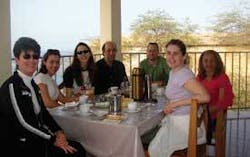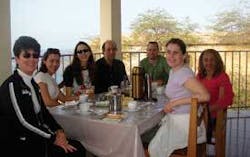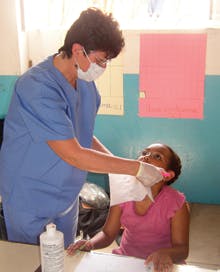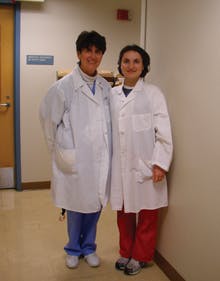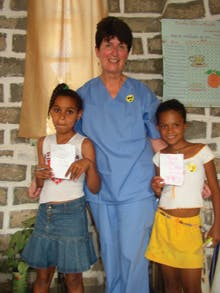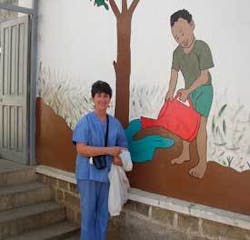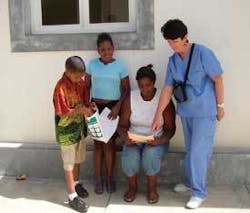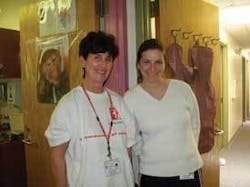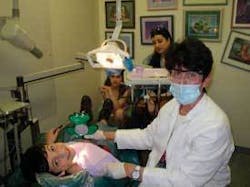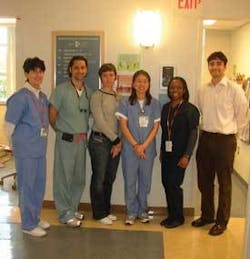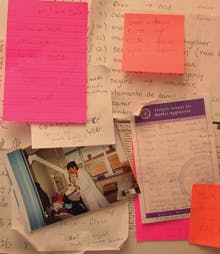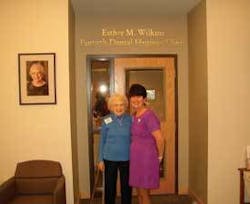Dientes, Dents, and Teeth: The Diary of an International Dental Hygienist
by Mary L. Kellerman, RDH, MS
A bra la boca. Ouvrez la bouche. Pozhálusta otkróite rot. Moo kholo. As a hygienist working for the Cambridge Health Alliance (CHA), I frequently ask patients to “open your mouth,” then subsequently find myself immersed in a different world. When I took this position, it was on a fill-in basis. More than five years later, I’ve not only grown to love it, I would miss the everyday excitement it brings. In the 1970s I volunteered at a homeless shelter (Bridge Over Troubled Waters) in downtown Boston, and on a health-care van in a neighboring migrant-populated town (Lawrence). Little did I know how CHA would someday employ me in its great challenge: addressing the dire need for access to care among Boston’s children and adults who have very high caries rates due primarily to poor socioeconomic status.
The original job description for the CHA position asked for a clinical health provider/educator for a population that spoke seven to 12 languages. Our target population now speaks more than 35 languages. Most of my coworkers are also not American-born; rather, the intercontinental staff hails from Scotland, China, Korea, Ethiopia, Haiti, El Salvador, and Cape Verde. In our lunchroom, we see not only forks, knives, and chopsticks, but an array of international foods such as arroz con pollo, empañadas, borscht, poi, sushi, and kimchi.
A scene from my first day on the job illustrates the cultural explosion: an elderly Chinese woman, accompanied by her trying-to-be-helpful daughter-in-law, was in pain, but didn’t want to remove her partial denture for us to take a look because she feared her teeth would come out with it. When neither I, an American hygienist, nor a Nigerian female dentist had any success convincing the patient to comply, a very outspoken oral surgeon from the Bronx came by the operatory and spoke the “magic words”: the patient “could die” from an infection if she didn’t remove the partial for an exam. The daughter-in-law dutifully relayed the urgent message to her mother-in-law, who immediately removed the partial and, unfortunately, the accompanying teeth with it. We had a lot of treatment ahead of us, but we had made a start, thanks to creative teamwork. My skills in these areas were shaped by my experiences in dental hygiene school more than 40 years ago.
When I graduated, Forsyth School for Dental Hygienists was a two-year associate’s degree program. It is now a bachelor’s degree program, and an online master’s degree program is in the works. It has a new site, the Massachusetts College of Pharmacy, with a state-of-the-art computerized clinic named after the esteemed Dr. Esther Wilkins. For almost 100 years, Forsyth has provided education to hygienists and treatment to local clientele. During her childhood, my mother hopped on the bus and train after school for a dime and headed over to Forsyth, where she received treatment for a quarter. Now, Forsyth students and instructors offer periodontal treatment and conduct stem-cell research, even growing teeth. During my tenure at Forsyth, we carried out twin studies for caries research, and the bacteria theory (strep mutans) had not yet been proposed! Before I entered the program, I thought being a foreign diplomat sounded intriguing, or possibly a biology major. Now I realize my career in dental hygiene has blended all of that for me and has indeed been a perfect mix.
Although I didn’t exactly follow in Madeline Albright’s footsteps, I feel fulfilled in my role as a dental hygiene provider, working with and for so many nationalities. I currently work with a dental hygiene co-therapist who was born in Georgia, the country that borders Russia, and she is teaching me Russian words and culture. Together we treat, and hopefully prevent, oral disease through daily guidance and education for the many needy people who flood our reception area. We also engage in outreach by performing screenings at local elementary schools. Additionally, we have a geriatric program in full swing. Our clinic is affiliated with the Harvard School of Dental Medicine, and the school’s dental residents rotate through our offices. Dental hygiene and assistant students from area programs also staff our clinics.
I constantly witness interactions between people from all over the world, and am proud to help patients who speak different languages or have different customs and need to receive optimal oral health care and knowledge. Dental hygiene treatment is no longer just using a porte-polisher or painting on fluoride. In our clinics, patients receive Cavitron and irrigation/soft tissue perio-management, fluoride varnishes, gel and rinse therapies, and restorative care. Since I have seen firsthand the benefits of fluoride, and the caries resulting from lack of fluoride, I have spearheaded campaigns to increase water fluoridation among municipalities in Massachusetts.
Boston has been fluoridated since the late 1960s, and now all Boston children and adults can benefit from drinking water from public sources. Ever since a group of students at Forsyth presented testimony for water fluoridation to inspire fellow classmates to become politically active regarding oral health issues, I have wanted to interact with the state legislature to promote the dental health and physical well-being of my fellow residents. Over the years, I have gone to the State House on Beacon Hill with the Massachusetts State Dental Hygienists’ Association to speak on tobacco ban issues, and I am currently campaigning for an initiative allowing access to health care for all citizens of Massachusetts. It is true that as dental hygienists and health providers, we can make a difference for our patients by giving them a voice. It is often very difficult for people who have little oral health knowledge to understand how to obtain care. Recently our clinic made signs in several languages for a dental health rally held in our patients’ neighborhood. Mine read, SAUDE PARA TODOS, which is “health for all” in Portuguese.
My experiences with promoting access to care and education for Boston’s immigrants have led me to consider both individuals and their families. For families who speak little or no English, our clinic treats whole families as units by bringing all members into the operatory, where we have interpreters present. Their medical and dental histories, customs, and fears are all discussed. We have found that using this discovery process is the most successful way for all family members to be involved. When the patients’ health and dental statuses are understood, treatment can move forward. I can relate to this phenomenon, for I’m sure if I were in a foreign land and unable to speak for myself, I would feel better with my relatives or health aides nearby.
Our clinic corridor walls are filled with displays of pamphlets that address such diverse topics as sexually transmitted diseases, oral cancer, tobacco/alcohol and drug habits, gingivitis and periodontal disease, baby bottle usage and caries, healthy diet choices, and root canal therapy. Armed with this information, patients are able to link dental treatment and caries prevention to total health. We also have show-and-tell booklets and videos in the children’s play and adult reception areas, and even the decorations are intended to educate. Young patients from around the world appreciate Colgate’s “Rabbit Around the World” series posters, because rabbits are on every continent.
On Tuesdays I am out of the clinic, screening and educating patients in the community with a wonderful individual who is trained in four languages, including American Sign Language, and who is truly a dental health education coordinator extraordinaire. She and I visit elementary and prekindergarten schools, mothers’ groups, and after-school organizations. We are often accompanied by Bronco Billy, the “dental mouth horse.” Together, we provide basic lectures on how to prevent “sick” teeth and gums, make healthy food choices, and protect teeth with fluoride and sealants.
We first demonstrate how to do something, then explain why it is important. For example, we talk about why people should go to the dentist, why athletes should wear mouthguards (Bronco Billy has chipped teeth), and why boys and girls should never start using tobacco. All children who participate receive bags filled with new toothbrushes, toothpaste, and floss, as well as a dental care information packet written in the parents’ native language. We screen more than 4,000 youths annually and receive great responses, especially when patients use our clinics and bring the informational packets with them. We see a significant reduction in untreated caries when we perform follow-up examinations or make check-up phone calls.
This year, we have also been involved with a new program called Tri-City Head Start. Head Start is a federally funded program that targets children under age 3, and our clinic has been selected to implement it in Massachusetts. We will be collaborating with an outside dentist, nutritionist, diet counselor, nurses, and social workers, as well as city administrators, school principals, and teachers to help establish the program in an area north of Boston. In conjunction with the Tri-City Head Start program, our clinic will help develop a Family Health Fair. I am thrilled to be part of these wonderful new endeavors where my coworkers and I are considered community health professionals, helping families to secure lifetime dental health care.
In addition to educating and procuring dental health services for local residents, I have spent considerable time teaching and advocating the needs of patients half a world away. In 2001, I was one of 18 dental hygienists selected to attend a People to People Ambassador Program to China. The trip enriched my life immeasurably. My preparation depended on the relationships I have with my international colleagues at CHA and my resourcefulness in collaborating with individuals and companies to effect change. A Chinese interpreter at CHA helped me fill out my paperwork. I obtained sponsorship from several dental companies in exchange for showing their products, such as a new color-changing sealant material and “stretchy” GUM® Expanding™ Floss, which were very popular items. China opened its doors to us, and we saw firsthand ancient and timeless eastern medical practices of herbs and acupuncture working in harmony with state-of-the-art implant dentistry.
We traveled first-class and toured clinics in Shanghai and Beijing. We climbed the Great Wall and visited the Forbidden City. One particularly poignant moment was during a visit to a village where the schoolchildren sang to us and gave us flowers. They had been waiting days for our arrival, and I’m sure I will never forget their beautiful faces and songs. We finished with a whirlwind shopping marathon in the many Hong Kong factories and shops. In addition to numerous souvenirs and photos, I have beautiful memories of the people and places that dental hygiene can impact. Sharing our skills and knowledge can inspire more international exchanges in the future.
A Chinese dentist called me when I returned home, hoping to obtain the fluoride varnish I had introduced to his elementary schoolchildren’s “Brush-In” program. There was talk of our returning to China to help the government establish more dental hygiene programs. I enjoy keeping in touch by e-mail with many hygienists from China and look forward to reuniting with them at annual ADHA Annual Sessions, where we catch up on each other’s lives and take new group photos of ourselves. We have developed a special camaraderie since we all shared an extraordinary dental hygiene international experience together.
I have also embarked on several missions with the volunteer organization Project Stretch/Dentistry for Children, http://www.projectstretch.org. Often the children in the areas served by Project Stretch receive their very first toothbrushes and dental exams through our efforts. Along with some coworkers, I help with fundraising efforts such as bake sales and yard sales, road races, golf tournaments, and wine-tasting events. We use the proceeds to buy dental supplies to supplement donated equipment. Since I have been affiliated with Project Stretch, I have become a frequent traveler to Central and South America. In 1997, I trekked to the barrios of Venezuela, and three years later completed a mission in Nicaragua. Last year I went to Teacapan, a fishing village in Mexico, and this past March I helped lead a team to a remote island called Brava that is part of Cape Verde. The island’s only medical doctor (an MD) delivers children and performs teeth extractions.
On these assignments, we seem not only to get accustomed to the absence of water and electricity - things we take for granted - but we form a unique bond by helping those who would not otherwise receive basic dental care. It has been very gratifying to work with so many great dentists, assistants, and hygienists toward a common goal. At the end of each trip, we leave instruments behind and set up equipment for others to use until our possible return. The hygienists establish fluoride rinse programs and leave enough toothbrushes, paste, and floss to treat local patients for a year.
Here are some highlights about my experiences and relationship with the dental hygiene profession:
- I ran a successful fluoridation campaign in my town of Billerica, Mass., in 1991.
- I entered graduate school at age 40 and obtained my master’s degree in dental public health from Boston University Goldman School, where I researched the effects of tobacco use on oral health.
- I have held state and local officer positions in my constituency for 20 years, including the Massachusetts Dental Hygienists’ Association presidency from 1995 to 1996.
- I have served as an alternate representative and a delegate from Massachusetts to the ADHA Annual Session many times.
- I have given testimony supporting the campaign for hygienists to be able to work as independent dental hygiene practitioners in outside settings.
- I am the current Massachusetts Tobacco Cessation Chair and ADHA Liaison. At CHA, I have direct access to a hospital program to which I routinely send patients for help to end their use of cigarettes, cigars, and bidi, as well as chewing tobacco, betel nuts, and other smokeless products.
- I developed a special reminder postcard for my patients in more than one language.
- I am a proud board member of the Forsyth Alumni Association. Last month I was thrilled to write two letters of recommendation to dental hygiene schools for coworkers, one from Haiti and the other from the Dominican Republic. It is a great feeling to be part of their decision to enter the field.
In conclusion, I must tell you about a very special meeting for dental hygienists that I attended for the first time three years ago in the beautiful city of Madrid. It was my first International Dental Hygiene Symposium, and it was awesome! It was such a gratifying experience that I have told every dental hygienist I know that they should go during their lifetime. To help finance my trip, I hoped to receive corporate sponsorship in exchange for my demonstrating products. I was fortunate enough to work out an arrangement with a great company and show teeth-whitening products to a late afternoon/cocktail hour crowd at the symposium. While I gave my demonstration in English, it was interesting that all presentations were prepared ahead of time in several languages so that each audience member could set the dial to listen to the message in his or her own language.
The opening and closing ceremonies blew me away. Hygienists from every country carried their national flags to the stage, where they remained throughout the symposium. When the hygienists carried the flags out on the final day, it was especially moving. More than 25 countries were represented; the symposium felt a lot like an Olympic event. When I heard the opening speaker refer to the head of my work program at CHA, Dr. Chester Douglass, and his project on world health, I sat up taller and felt connected to every hygienist in the room and across the universe! Since I returned home from the symposium, I have been working to recruit dental hygiene colleagues as possible roommates in Toronto (I promise I don’t snore!) and encouraging them to join the International Federation. Attending meetings is a great way to stay connected to hygienists around the world. We all have oral health as our goal, and if we can share information, have open discussions, resolve issues, and make universal mandates, we can all benefit - ourselves as international hygienists, and all of our patients on this planet!
Mary L. Kellerman, RDH, MS, works as a hygienist for the Cambridge Health Alliance in Cambridge, Mass. She is a member of the Massachusetts Dental Hygienists’ Association and the American Dental Hygienists’ Association. You may contact her at [email protected].
